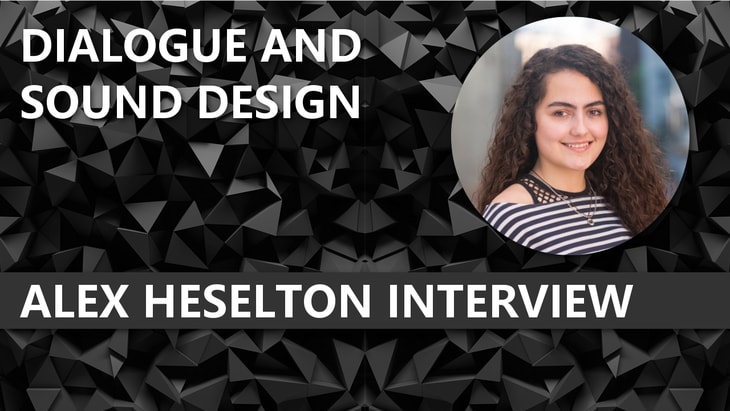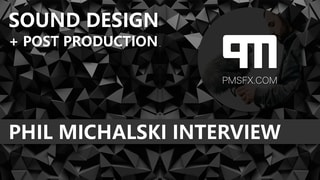Updated: May 30, 2019
Share!
Alex Heselton Interview - Dialogue & Sound Design

This interview with Alex Heselton will teach you a lot about dialogue, sound design, and the contrast of diversity at the workplace.
With experience working on indie and AAA games from in-house, freelance, or from an out-of-house studio, she knows her way around the audio battlefield.
Stick around, there is tons of information and insight in this interview!
Q: To introduce yourself, what is your experience in game audio and what are you doing right now?
Even though I am relatively early on in my career with a little over three years of professional experience, I’ve been lucky to already experience an excitingly varied introduction to game audio. My masters program in Technology and Applied Composition at the San Francisco Conservatory of Music offered a broad curriculum of mixed media audio, but allowed me the freedom to specialize in game audio both in school and out. We had a partnership with Sony in which we had the opportunity to compose a piece as a demo for a fictional game brief, then record at their studios in San Mateo.
I utilized the skills we learned in composition, sound, design, and implementation to work on several freelance indie games such as the Fear Forest by River Liu, which was also my first foray into dialogue (although unfortunately with me as the actor!) It was through my knowledge of coding and Max / MSP that I got my job at EA working as a sound and dialogue designer, where we recorded and edited almost everything in our in-house built Max / MSP patch!
I’m now currently in London working for the dialogue post-production house Side UK, with freelance sound design and composition projects for both game and film on the side (no pun intended). The highlight of my career so far has to be speaking on a panel in LA at GameSoundCon’s first dialogue track last October.
Q: What does the process of creating a new language from scratch look like? Is there anything that should be avoided or taken caution with?
Conlanging, or the process of constructing a language, can vary depending on the needs of the game. If you are creating a language for a fictional world that is modeled or inspired by a real location on Earth, then it often goes hand in hand that the language you are designing will be inspired by the dialects of that region. There are many reasons for why you might do this; it makes the fantasy world you are in more believable and authentic, creating a more immersive experience for the player. You also bypass some localization issues, if you’ve created this language especially for the game then there is no need to translate and re-record it across the different regions where it will be released – subtitles will suffice.
It should be noted however that great care and consultation should be taken with native speakers of any language from which you draw inspiration. During the process of creation to ensure your conlang inherits some of the defining features of the parent language, and in quality assurance checks as it is integral that your new language doesn’t use any actual words or phrases from the real language - so your conlang has a life and character of its own and to refrain from conveying unintentional messages to native speakers.
Take for example even from my work on the Sims. Simlish differs from game languages such as Dovahzul (from Skyrim, which aimed to sound Nordic), in that its aim is not to emulate or replicate in any way a real language. Instead its origins are, like a lot of game audio, rooted in trying to escape repetitive sound. In the original The Sims, it was thought that if it was different enough from any language the brain would have a hard time recognizing phrases, eliminating repetition. It also had the effect of enhancing the open-world open-play nature of the game as it allows the player's imagination to take control.
Interestingly for a conlang, it came into existence through quite a natural process. Even to this day, the voice actors improvise the majority of Simlish. Although now there are pages of ‘cheat sheets’ that contain ‘Simlish-sounding’ words for them to draw inspiration from.
For the jungle adventures pack (which was designed to be set in a Simlish-style South America) we tried to design some more Spanish-sounding Simlish lexicon. All this being said, I was speaking to a Bulgarian friend recently who hadn’t played the Sims since their childhood when their only language was Bulgarian. To them, what we had worked so hard to make sound like gobbledygook, sounded perfectly like English. It shows how easily your conlang can slip into what sounds natural to you - despite your best intentions!
Q: How does your experience in sound design benefit dialogue design and vice-versa?
Sound design and dialogue ended up being very interweaved during my time at EA. We also edited all the dialogue directly to the animation with which it would be called in-game, to follow the emotion of the action. As the language is more of a collection of sounds than translatable words, the whole process was more of an activity in sound design than dialogue.
So for me personally, working with dialogue has really helped shaped my sound design skills.
I’ve gotten used to thinking about how to convey a story, a meaning, or an emotion with a sound. It’s so useful for seeing sound design in a narrative light.
On the other hand, sound design has really helped develop my technical chops, which is transferable to dialogue editing. With speech, it can be easy to think more about what a character is saying rather than how they are saying it, or the quality of the audio. Although this was a lot easier when the dialogue was Simlish, as I couldn’t understand what they were saying!
Q: What are the most important things to discuss with the rest of the team making the game when dealing with dialogue?
One of the worst things about working in game audio is that you are at the end of the development pipeline. This means that too often than not, each discipline misses their deadline, gradually eating into the audio lock, eventually resulting in you being handed a bunch of assets to assign sounds to. It’s important to stay in communication with developers so you can at least pre-empt the bulk of the work.
Inter-disciplinary communication is of vital importance with regard to dialogue. Not only with engineers to plan an audio system but also with writers and narrative designers. This is something I spoke about on my panel at GameSoundCon and it’s a big disconnect I’ve noticed moving from an in-house audio team to an out-of-house post-production studio.
In a post-production studio you’re not a part of the same process, and not in communication with the rest of the team. So while I get to work on a vast array of AAA titles concurrently I also lose out on a part of the creative process, and as a result, I find myself playing it safe a lot more with audio design. Whether you are working in-house or out-of-house, if there is a team of you editing the same dialogue then communication within your coworkers is also integral. Everyone has their own methods and workflow, but it’s important to come together from time to time for peer review to make sure you aren’t beginning to stray too far from each other. The aim is to have coherent audio that sounds like one person edited it. Without good dialogue, a narrative video game will fall apart, whereas a well-written story can stand by itself.
Q: Do you think dialogue can benefit from being integrated into the development cycle earlier on? What are the biggest differences in dialogue for film vs for games?
Dialogue editing has a tendency to be seen as a very simple task – trimming tops and tails, and cutting clicks and pops. At EA when we were working on the cats and dogs expansion pack for the Sims 4, I had been a part of the process since the initial character design. So when it came to the alley cat character I knew to leave in and even emphasize things that would traditionally be cut – nasal and guttural utterances, snorts and slobbery clicks.
Depending on the game you are working on dialogue in video games can work in a similar way to with films, especially when it comes to cutscenes. I’d say the first real difference is in the number of lines. The average film has roughly 1000 lines of script, I’ve worked on video games that have had upwards of 80,000 lines of dialogue. Then, of course, there is the nonlinear nature of games! In a movie you can treat all the dialogue in a scene almost like one instrument, once everything is in the right place it never needs to move or shift and you can melt it into the mix without worrying about a random drone strike drowning out the story.
This is another reason why dialogue and audio planning should be rooted into the inception of the game. How do you carry a narrative over an active battlefield? How do you still alert the player to danger? How do you ensure that all the surrounding NPC’s don’t start to phase as they’ve all called the same voice file by the same voice actor at the same time? You’re weighing up dialogue, sound design, UI, and music in one interactive mix.
Even when sound is cut to animation like in film, that one animation could be pitted against an unprecedented number or relationships and interactions with other animations. It’s a whole living system and it’s not just essential to plan and design for good audio, but as each of these systems feed back into each other it’s also integral for good gameplay.
Q: Are there some struggles you faced as a woman in game dev and what is your advice to others who may be experiencing the same?
I've actually had somewhat of a reverse experience when it comes to being a woman in game development. My masters program was headed by an amazing woman, MaryClare Brzytwa, who made it her mission to have an equal number of female and male students. There were actually more women than men the year I was there! Every Friday we would have a talk from an industry professional, and MaryClare would ensure that we were exposed to a wide variety of successful women from all walks of game audio. Then when I was working at EA I had an incredible female boss, Jackie Perez Gratz, and by the end of my time there all my fellow colleagues were also women. I was definitely sheltered from the realities of the industry by my very fortunate introduction to game dev.
I think the first time I realized that my experience wasn't a common one was when we had a tour of students from the new game audio program at the San Francisco State University, a class of thirty or so guys. It's rough to see a lack of diversity because the demographic you have in a freshman class is four years away from entering the workforce. Schools are by no means the only or best way to start a career in game audio, but they're a good indicator of where we'll be in five years time, which is why I think it's so important that we look at ways that we can increase the diversity of applicants.
I now work in an all-male studio so I'm starting to experience some of the struggles that most women in this industry face. It’s making me appreciate even more my introduction to the industry, and I can recognize that being surrounded by female role models who have worked so tirelessly to lift up other women has been a big part of my success. This is why it’s so important that we create space for women, LGBT folk, and people of color at the head of the industry; the rest will follow.
If there’s anyone out there struggling as a minority then know you’re not alone, reach out and build a support group around you – it doesn’t have to be within the same studio, it could be in your city, or online even, and also know that just by being present in your job you are so important to paving the way for future generations.
Q: What do you think is the most effective way we can create awareness and diversity in the video game industry?
I think the thing that everyone can do to help is to support existing women, queer folk, and POC in the gaming industry. There’s plenty of games out there made by these folk, especially in indie gaming.
A great one that came out recently is Dance of Death: Du Lac & Fey. It’s made and written by a queer woman of colour and features some amazing historically accurate dialogue and voice performances, as well as queer narratives that are respectfully and appropriately told.
Supporting minority artists already in the industry is the best form of protest to the homogeny found in big name companies. Outside of the gaming community, we need better showcases of minority talent. Offer up panel and conference slots to women and POC, not only so they can increase their exposure but also to show to any budding female talent that there is room for them in this industry.
Finally, outreach, outreach, outreach! Before MaryClare recruited me for the SFCM program I was under the impression that I could never make it in video games. Outside of my gender even, I felt that my education and experience were so behind where they would need to be for my first gig.
MaryClare showed me that for those with less access to opportunities be it gender, finance, or ethnicity, sometimes all that is needed is a helping hand or a friendly push. My boss at EA would always say it wasn’t about actively hiring women, but trying to ensure that the pile of resumes was 50/50.
Q: What is the best advice you can give to anyone in dialogue or sound design? Also, any final thoughts?
My best advice for the game audio industry would be to ask for advice! It might sound strange but one of the best things about this industry is the people in it, I’ve found folks at conferences that are looking to switch over from film and TV for this very reason. I’m not denying how hard it can be to get started (or keep going for that matter!), but it doesn’t feel as cutthroat or two-faced as other aspects of audio and media can. It’s an increasingly diversifying group of incredible people - some who have been involved in game audio since video games first began! So take advantage of this support group, get involved with groups on Facebook (especially for women in game audio) and don’t be afraid to reach out and offer to buy someone lunch in return for some wise words. It’s truly a community and the people further along in their careers are so ready to help bring up those just starting out.
My second best advice would be to do what you love! Get stuck in with all aspects of game audio and find out what you truly enjoy doing. It sounds rough, but generally speaking there’s always going to be someone better than you - or at least a hundred just as good as you. So passion can go a long way, and be the thing that sets you apart from the crowd. Obviously you still have to have the chops, but you can’t fake passion.
If you are interested in Alex's work, check out her website showcasing her Composition and Sound Design work.
I hope you enjoyed this interview with Alex Hesselton. As always, thanks for reading.
Featured Post
Share!
Join the newsletter for free stuff and some knowledge too!
Everything you need. No Spam. A heads up before others do.









